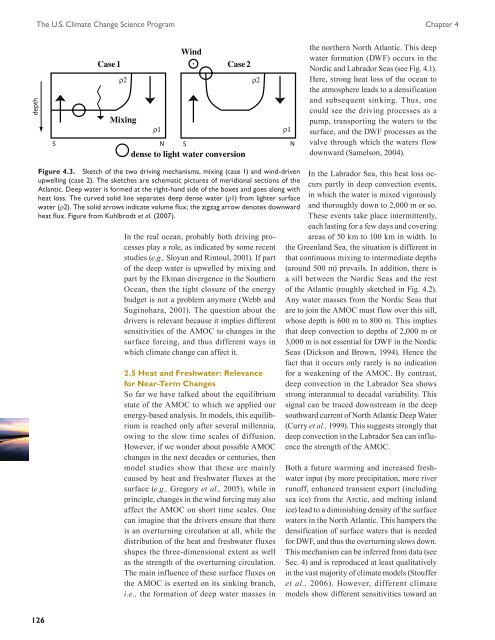Book 2.indb - US Climate Change Science Program
Book 2.indb - US Climate Change Science Program
Book 2.indb - US Climate Change Science Program
- No tags were found...
You also want an ePaper? Increase the reach of your titles
YUMPU automatically turns print PDFs into web optimized ePapers that Google loves.
The U.S. <strong>Climate</strong> <strong>Change</strong> <strong>Science</strong> <strong>Program</strong> Chapter 4depthSWindCase 1Case 2ρ2ρ2Mixingρ1NSdense to light water conversionρ1Nthe northern North Atlantic. This deepwater formation (DWF) occurs in theNordic and Labrador Seas (see Fig. 4.1).Here, strong heat loss of the ocean tothe atmosphere leads to a densificationand subsequent sinking. Thus, onecould see the driving processes as apump, transporting the waters to thesurface, and the DWF processes as thevalve through which the waters flowdownward (Samelson, 2004).Figure 4.3. Sketch of the two driving mechanisms, mixing (case 1) and wind-drivenupwelling (case 2). The sketches are schematic pictures of meridional sections of theAtlantic. Deep water is formed at the right-hand side of the boxes and goes along withheat loss. The curved solid line separates deep dense water (ρ1) from lighter surfacewater (ρ2). The solid arrows indicate volume flux; the zigzag arrow denotes downwardheat flux. Figure from Kuhlbrodt et al. (2007).In the real ocean, probably both driving processesplay a role, as indicated by some recentstudies (e.g., Sloyan and Rintoul, 2001). If partof the deep water is upwelled by mixing andpart by the Ekman divergence in the SouthernOcean, then the tight closure of the energybudget is not a problem anymore (Webb andSuginohara, 2001). The question about thedrivers is relevant because it implies differentsensitivities of the AMOC to changes in thesurface forcing, and thus different ways inwhich climate change can affect it.2.5 Heat and Freshwater: Relevancefor Near-Term <strong>Change</strong>sSo far we have talked about the equilibriumstate of the AMOC to which we applied ourenergy-based analysis. In models, this equilibriumis reached only after several millennia,owing to the slow time scales of diffusion.However, if we wonder about possible AMOCchanges in the next decades or centuries, thenmodel studies show that these are mainlycaused by heat and freshwater fluxes at thesurface (e.g., Gregory et al., 2005), while inprinciple, changes in the wind forcing may alsoaffect the AMOC on short time scales. Onecan imagine that the drivers ensure that thereis an overturning circulation at all, while thedistribution of the heat and freshwater fluxesshapes the three-dimensional extent as wellas the strength of the overturning circulation.The main influence of these surface fluxes onthe AMOC is exerted on its sinking branch,i.e., the formation of deep water masses inIn the Labrador Sea, this heat loss occurspartly in deep convection events,in which the water is mixed vigorouslyand thoroughly down to 2,000 m or so.These events take place intermittently,each lasting for a few days and coveringareas of 50 km to 100 km in width. Inthe Greenland Sea, the situation is different inthat continuous mixing to intermediate depths(around 500 m) prevails. In addition, there isa sill between the Nordic Seas and the restof the Atlantic (roughly sketched in Fig. 4.2).Any water masses from the Nordic Seas thatare to join the AMOC must flow over this sill,whose depth is 600 m to 800 m. This impliesthat deep convection to depths of 2,000 m or3,000 m is not essential for DWF in the NordicSeas (Dickson and Brown, 1994). Hence thefact that it occurs only rarely is no indicationfor a weakening of the AMOC. By contrast,deep convection in the Labrador Sea showsstrong interannual to decadal variability. Thissignal can be traced downstream in the deepsouthward current of North Atlantic Deep Water(Curry et al., 1999). This suggests strongly thatdeep convection in the Labrador Sea can influencethe strength of the AMOC.Both a future warming and increased freshwaterinput (by more precipitation, more riverrunoff, enhanced transient export (includingsea ice) from the Arctic, and melting inlandice) lead to a diminishing density of the surfacewaters in the North Atlantic. This hampers thedensification of surface waters that is neededfor DWF, and thus the overturning slows down.This mechanism can be inferred from data (seeSec. 4) and is reproduced at least qualitativelyin the vast majority of climate models (Stoufferet al., 2006). However, different climatemodels show different sensitivities toward an126






